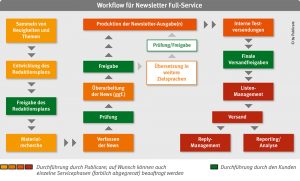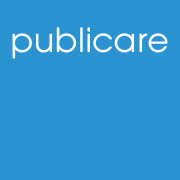
Yesmail surprises with “study” on iOS list unsubscribe
29. November 2016
Email clicks from the firewall
10. October 2018
10 steps to a successful customer newsletter

There are many points to be aware of when you’re drafting a newsletter for existing customers. Clients don’t like to hear the same old marketing mishmash again and again. A view beyond the marketing horizon can be helpful in two ways. Inside the company, different departments provide interesting and diverse content for the customer newsletter. Proven external methods from journalism and project and knowledge management are useful for collecting information efficiently. Find out more in our blog post.
Companies usually dedicate the bulk of their marketing budget to the acquisition of new customers. However, existing clients often yield a significantly higher sales potential via cross- and upselling. They often only need a little nudge to buy a new or higher performing product. A customer newsletter with relevant content binds and activates existing clients in an appealing way. The prerequisites for reaching this goal are a well-planned newsletter workflow, in-house research and a tightly organised way of working. Publicare has compiled the best tips and methods from different disciplines:
1. Draw up an editorial plan
No magazine or journal is produced only shortly before its day of publication. Content that appears to the reader as though it had been written only yesterday often is the result of long research and insider information that was known well before. When you’re creating the editorial plan for the customer newsletter, you are the editor-in-chief. Use in-house expertise, events and release dates to compile contributions as early as possible and publish on time.
An editorial plan for your newsletters helps you avoid frantic last-minute efforts. On the basis of the deadline fixed in the editorial plan, it’s easy to define the latest start date for research and production.
Moreover, the editorial plan makes your newsletter more diverse, because the clear schedule for the send out dates makes it possible to arrange the treated topics in a reasonable manner. If a topic is too broad for a single article, you can split it up and include it as an article series in parallel to the current topics. This will give your recipients a reason to read the next newsletter, too.
What should you do if you just can’t find any relevant news before the deadline? Resist the urge to fill up “empty slots” with irrelevant articles and keep the newsletter lean or postpone the next send out date. In general, with email marketing campaigns, relevance should prevail over continuity. Your readers will be grateful for it.
The research for relevant topics can also be carried out by a service provider. Besides that, you can source out the monitoring and observation of competitors.
2. Gather information from different business units
Many companies place responsibility for customer communication on the PR or marketing department. Their proximity to advertising and experience in goal-oriented media communication makes them seem almost predestined to it.
Unfortunately, many marketing departments only dip into the same closely related areas: the news of the product marketing, channel marketing and partner marketing departments and of course of the executive management. The resulting stories are the same ones that the marketing department also tells in press releases: what has changed on the executive board, which charity campaigns were mounted, where did the managing director give a speech?
Topics that relate to the practical interests of the customers remain untouched. Why not deal with key topics of first level support in order to strengthen customer loyalty? Or let product developers explain helpful workarounds?
When you’re searching for relevant information, take a look beyond the horizon – and what is even more important – behind the doors of all departments.
To which of these departments does your customer newsletter refer to regularly?
Didn’t tick anything? Then there’s still potential for optimisation in the communication with your existing clients.
3. Create diverse formats
With “thou shalt not bore”, Billy Wilder formulated a rule that, after all, applies to all media. Not to bore means, for example, to diversify text and news types. If you broaden your news sources and include other departments as suggested above, a more varied content mix is the obvious result. Some types of content are particularly suitable for certain communicative goals.
Classical newsletter content created by marketing departments is supposed to impress and underline professionalism:
- Staff news
- Corporate figures
- User reports
- Information about new products
- Information about new partnerships
To unlock cross- and upselling potential with your existing clients and create a significant additional turnover, include content such as:
- Announcement of new trainings
- Product add-ons
- Product upgrades
- Trade-in sales promotions (“new for old”)
- Support offers
- Product-related services
To strengthen customer loyalty, suitable content can be:
- Event information (in-house and well-known conferences and trade fairs)
- Workarounds and tips for troubleshooting
- New distributors
- New prices
- News from the development department
Short texts should be predominant in the customer newsletter. After all, customers have very little time to read. From time to time, you can include longer articles for the lunch break.
4. Collect relevant content
Newsletter contributions that bring an added value for the reader are likely to be read. At the same time, your company should benefit from every contribution, too. Consider which information strengthens customer loyalty and which improves cross- and upselling. Are there new products or insights that make the customer’s life easier or even cause an increase in efficiency or sales? Although the construction of a new plant may be a great thing for the company itself, for the reader it’s rather an interesting side note. But if you can make clear to him that this causes significant advantages like shorter production times or more attractive price structures, the information will remain in his head.
Personalised newsletters are another possibility to increase relevance. Modern email marketing systems support the selective attribution of newsletter articles to segments of the mailing list. Some sections are addressed to all clients. Other content elements are sent only to recipients with a technical background, while some only go to the buyers of certain products. In most companies, sources for customer characteristics like job or purchasing history already exist: the CRM system and other data bases.
5. Newsroom instead of enforced writing

Image: Andreas Berheide / photocase.de
Press releases and the relevant specialised press sometimes report on newsletters and blogs maintained by intrinsically motivated employees in production, product development or administration. Only on rare occasions, somebody explains which financial efforts were necessary to motivate and train the employees for writing articles. What is more, many employees are hardly willing to write anything due to their high workload and job description. Apart from that, you can’t expect every employee to have the technical capacities that are necessary for informational writing.
Creating a newsletter is a service task that should burden employees as little as possible. You can reach good results with a conservative, but reliable solution: a team of in-house or external editors that, just like the heads of department in a newsroom, are responsible for certain business units and together stay on top of all topics.
What is a newsroom?
The first newsroom was created in the autumn of 1994 in Philadelphia. Strict boundaries between departments were dissolved and the editors-in-chief of all departments came together in one big office. This created synergies and put an end to thinking in departmental competences. Of course you don’t need a spatial restructuring in order to draw up a successful customer newsletter. A change in thinking and of responsibilities now and then are sufficient.
6. Fish in the in-house pool of information
Information and stories that stem from other sources than the classical marketing ones increase the success of the newsletter. But how can newsletter editors become aware of circulating technical information? Our recommendation: In every company, there is a constant flow of information – an explicit one in documents, email distribution lists, social media and news feeds and an implicit one in form of conversations, thoughts and ideas. The explicit flow of information is an efficient pool to fish in. You’ll always find something on the intranet or extranet and in meeting minutes.
Asking all employees for their implicit knowledge might be a reasonable instrument for human resources policy, but for a regularly published newsletter, it is too inefficient. Instead of that, an experienced member of staff can assume this responsibility. He can act as contact person for questions and take on the task to obtain information that is difficult to capture.
7. Collect knowledge with the microphone
For the acquisition of knowledge, we’ve got a useful tip: Consider the conversation with the specialist colleagues as an interview and record it. This way, the person that delivers important content doesn’t have to write summaries or even complete articles and the editor can concentrate completely on the conversation. In a dialogue, it’s often easier to identify the relevant key message and the central theme and make the account a good story. Moreover, an experienced interviewer steers the conversation and avoids digressions. The external perspective of the interviewer and the targeted questions help the respondent discover aspects he would not have become aware of if he had written the article on his own.
8. Avoid advertising-speak
When dealing with existing clients, advertising-speak is even more inappropriate than in the acquisition of new customers, where content marketing is omnipresent.
Existing customers know your products and services and do not have to be convinced with many words. What counts are objectively explained facts with a call to action that gives the customer the possibility to act.
9. Keep decision making processes short
When it comes to evaluating the relevance of content, you definitely have to put an end to grassroots democracy and the culture of consensus. Otherwise, endless discussions and jam-packed newsletters that in large parts are irrelevant lie ahead. This is because in large groups, there will always be someone who considers every information as relevant for every target group or who absolutely insists on spreading all the news from his department.
Of course, representatives of marketing and/ or the executive management should be involved in the decision making process – they are in the best position to assess matters of corporate policy that stand for or against the publication of specific information.
10. Push through deadlines
In the first paragraph, we mentioned the guiding principle that relevance should prevail over continuity – and now we plead for sticking strictly to deadlines? Isn’t that contradictory?

Image: birdys / photocase.de
Here, too, relevance is decisive. It’s the right decision to postpone or cancel a send out if there is no relevant newsletter content. However, deadlines are often postponed because additional relevant content is predicted to arrive. A brand new story that just came in or was released with delay could make the customer newsletter even better.
But the fact is that sometimes months go by before the newsletter is finally ready. Due to a well-meant perfectionism or too much consideration, it is much too long and if things go badly, contacts who are no longer interested will delete it instantly. Also, in case of multilingual newsletters, concessions cause a cost-intensive division into several separate texts. That´s why right from the start, project managers should communicate clearly and reliably that the customer newsletter will only contain contributions that are handed in in their complete form before the deadline.
How to go on
The editorial plan is ready, you have found exciting topics, have done research and written great articles. Now you can start sending, can’t you?
In our article we described the way to find the right content mix for a customer newsletter. But before you can send the content to all clients, you still need to take a few decisions and steps.
- Who releases the newsletter before the send out?
- Have you defined a design for the newsletter?
- By which ESP should the newsletter be sent?
- Who is in charge of testing the newsletter?
- Is the target list complete? Who takes care of list management?
- How do you measure success? Who is responsible for reporting?
- If customers react: Who is in charge of reply management?

We will be pleased to support you in all phases of the creation of your newsletter. Contact us directly or leave a message in the comment field.



